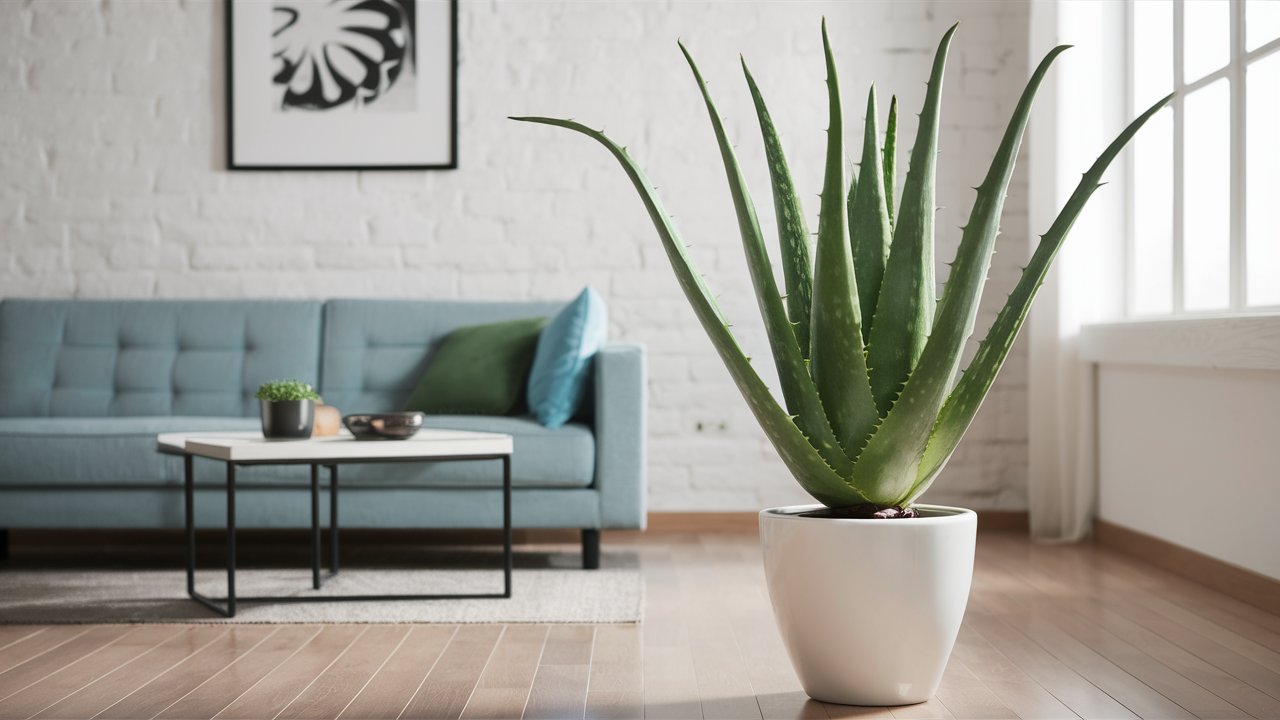Disclosure: Some links on this site are affiliate links. As Amazon Associates, we earn from qualifying purchases (at no cost to you).
Are you looking to add a little green to your life? Aloe Vera, known for its soothing and healing properties, is a fantastic plant for beginners.
It’s not just easy to care for but also provides a natural remedy for burns and skin irritations. Ready to dive into the world of Aloe Vera care?
10 Crucial Aloe Vera Care Tips
Choose the Right Pot

Aloe Vera plants need a pot with good drainage. A pot with drainage holes at the bottom is essential to prevent water from sitting at the roots, which can cause rot. Think of it like a hot tub – too much soaking is never a good thing unless you’re a prune!
Use Well-Draining Soil

Aloe Vera thrives in a cactus or succulent potting mix. You can also make your own mix with equal parts sand, perlite, and regular potting soil. Remember, Aloe Vera is not a fan of being too wet. It likes things dry and breezy – much like a weekend at the beach!
Water Sparingly
When it comes to watering, less is more. Allow the soil to dry out completely between waterings. During the summer, watering once every three weeks should suffice. In the winter, you can stretch it to about once a month. Remember, it’s an Aloe Vera, not an aquatic plant!
Provide Plenty of Light
Aloe Vera loves sunlight. Place your plant in a bright, sunny spot. A south- or west-facing window is ideal. However, avoid direct sunlight all day, as it can scorch the leaves. If your Aloe starts to stretch out or lean, it’s probably not getting enough light.
Avoid Overcrowding
Aloe Vera needs space to breathe. Avoid planting multiple Aloes in one pot. Overcrowding can lead to poor air circulation and increase the risk of pests and diseases. Give each plant its own pot so it can spread its leaves and roots comfortably.

Fertilize Sparingly
Feed your Aloe Vera sparingly. A light application of a balanced houseplant fertilizer at half strength once or twice a year during the spring and summer is plenty. Over-fertilizing can cause more harm than good, leading to salt buildup in the soil and damaging the plant.
Watch for Pests
Although Aloe Vera is quite hardy, it can occasionally attract pests like aphids, mealybugs, and spider mites. Inspect your plant regularly. If you notice any unwelcome visitors, treat the plant with a natural insecticidal soap or neem oil. And remember, a happy plant is a pest-free plant!

Handle with Care
Aloe Vera leaves are delicate and can break easily. Handle your plant gently. If you need to move it or repot it, do so with care to avoid damaging the leaves. Broken leaves can heal, but it’s best to prevent injury in the first place.
Prune Dead Leaves
Remove dead or damaged leaves promptly. This helps keep the plant healthy and encourages new growth. Use a sharp, clean knife or scissors to cut off the leaves at the base. And hey, those cut leaves? They can still be used for their soothing gel!

Repot When Necessary
Aloe Vera doesn’t need to be repotted often, but when it outgrows its pot, it’s time for a move. Typically, repotting every two to three years is sufficient. Choose a pot that’s one size larger and refresh the soil mix to give your Aloe some new nutrients.
Biggest Aloe Vera Mistakes
Growing Aloe Vera can be an enjoyable and rewarding experience, but there are common mistakes that beginners often make which can lead to the plant’s poor health or even death. Understanding these pitfalls can help you avoid them and keep your Aloe Vera thriving.

Overwatering
- Aloe Vera is a succulent, meaning it stores water in its leaves and can tolerate dry conditions.
- Frequent watering can lead to root rot, which is often fatal.
- It’s essential to let the soil dry out completely between waterings.
- General guideline: water once every three weeks during summer and even less in winter.
Using the Wrong Soil
- Aloe Vera needs well-draining soil, such as a cactus or succulent mix, to prevent water from sitting around the roots.
- Regular potting soil can retain too much moisture, leading to root rot and other issues.
- Mixing regular potting soil with sand and perlite can create a suitable environment for Aloe Vera.
Incorrect Lighting
- Aloe Vera thrives in bright, indirect sunlight.
- Placing it in a dark corner can cause the plant to stretch out and become leggy, seeking more light.
- Too much direct sunlight, especially in hot climates, can scorch the leaves.
- Ideally, place your Aloe Vera in a south- or west-facing window for the best light conditions.
Avoiding these common mistakes can help ensure your Aloe Vera remains healthy and vibrant, bringing a touch of green and a wealth of benefits to your home.

Frequently Asked Questions
1. How often should I water my Aloe Vera? Watering once every three weeks in the summer and once a month in the winter is usually sufficient. The key is to let the soil dry out completely between waterings.
2. Can Aloe Vera grow in low light? Aloe Vera prefers bright, indirect sunlight. While it can tolerate low light, it may become leggy and weak. For best results, place it in a bright, sunny spot.
3. What should I do if my Aloe Vera leaves turn brown? Brown leaves can be a sign of overwatering, underwatering, or too much direct sunlight. Check your watering schedule and adjust as needed, and ensure your plant is getting the right amount of light.
4. How do I treat pests on my Aloe Vera? Use a natural insecticidal soap or neem oil to treat common pests like aphids, mealybugs, and spider mites. Regular inspection can help catch pests early.
5. Can I use regular potting soil for my Aloe Vera? Aloe Vera prefers well-draining soil. A cactus or succulent potting mix is ideal, or you can make your own by mixing equal parts sand, perlite, and regular potting soil.
Final Thoughts
Caring for Aloe Vera is straightforward and rewarding. By following these tips, you can ensure your Aloe Vera plant thrives and remains a beautiful, beneficial addition to your home.

Remember, Aloe Vera is a low-maintenance plant that doesn’t need constant attention – just the right conditions to grow happily. So, give your Aloe some love, but not too much water, and enjoy the many benefits this wonderful plant has to offer.
And if all else fails, just remember – even a brown thumb can turn green with a bit of practice!


